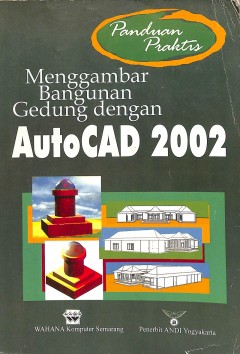Ditapis dengan

Tip&Trik optimasi vba microsoft excel
- Edisi
- 2008
- ISBN/ISSN
- -
- Deskripsi Fisik
- 259 p.
- Judul Seri
- -
- No. Panggil
- TXT GEN YUD t C.1
- Edisi
- 2008
- ISBN/ISSN
- -
- Deskripsi Fisik
- 259 p.
- Judul Seri
- -
- No. Panggil
- TXT GEN YUD t C.1

The wisdom and teachings of stephent R. covey
- Edisi
- 2012
- ISBN/ISSN
- -
- Deskripsi Fisik
- 160 p.
- Judul Seri
- -
- No. Panggil
- TXT LE STE t C.1
- Edisi
- 2012
- ISBN/ISSN
- -
- Deskripsi Fisik
- 160 p.
- Judul Seri
- -
- No. Panggil
- TXT LE STE t C.1

Belajar merawat Indonesia
- Edisi
- 2012
- ISBN/ISSN
- -
- Deskripsi Fisik
- 282 p.
- Judul Seri
- -
- No. Panggil
- TXT LE ADI b C.1
- Edisi
- 2012
- ISBN/ISSN
- -
- Deskripsi Fisik
- 282 p.
- Judul Seri
- -
- No. Panggil
- TXT LE ADI b C.1

Manager's guide to social media
Facebook, Twitter, and YouTube have changed everything. Some managers fear their employees will waste entire days using online social media. Smart managers, though, understand that social media is a powerful tool for engaging customers and growing their business.
- Edisi
- -
- ISBN/ISSN
- 978-0-07-175433-0
- Deskripsi Fisik
- xiii,193 p, 23 cm; index
- Judul Seri
- -
- No. Panggil
- 006.7024 KLO m

Getting close from far away: zoos on the Internet
Provides a guide to the increasing number of zoos and associated sites now using the Internet. Investigates the multiple roles of the Internet for zoos, their staff and visitors,in helping them to communicate science and provide a cultural service to the public, in addition to serving as a means of marketing and publicity.
- Edisi
- Volume 5 · Number 3 · 1995 · pp. 32–36
- ISBN/ISSN
- 1066-2243
- Deskripsi Fisik
- 7 p.
- Judul Seri
- Getting close from far away
- No. Panggil
- ATC MR BEN g

Fathoming Porter’s five forces model in the internet era
- Edisi
- VOL. 7 NO. 6 2005
- ISBN/ISSN
- 1463-6697
- Deskripsi Fisik
- 13 p.
- Judul Seri
- -
- No. Panggil
- ATC MG KAR f
- Edisi
- VOL. 7 NO. 6 2005
- ISBN/ISSN
- 1463-6697
- Deskripsi Fisik
- 13 p.
- Judul Seri
- -
- No. Panggil
- ATC MG KAR f

An intelligent tracking system based on internet of things for the cold chain
- Edisi
- Vol. 26 Iss 2 pp
- ISBN/ISSN
- -
- Deskripsi Fisik
- 15 p.
- Judul Seri
- Internet Research
- No. Panggil
- ATC LO BUL i
- Edisi
- Vol. 26 Iss 2 pp
- ISBN/ISSN
- -
- Deskripsi Fisik
- 15 p.
- Judul Seri
- Internet Research
- No. Panggil
- ATC LO BUL i

Distribution and logistics development in China: The revolution has begun
- Edisi
- Vol. 32 Iss 9 pp. 783 - 798
- ISBN/ISSN
- -
- Deskripsi Fisik
- 21 p .
- Judul Seri
- International Journal of Physical Distribution & Logistics Management
- No. Panggil
- ATC LO EDM d
- Edisi
- Vol. 32 Iss 9 pp. 783 - 798
- ISBN/ISSN
- -
- Deskripsi Fisik
- 21 p .
- Judul Seri
- International Journal of Physical Distribution & Logistics Management
- No. Panggil
- ATC LO EDM d

Developing a framework for measuring physical distribution service quality of…
Many traditional retailers use the internet as a complementary business channel and thus sell products through multiple channels. In contrast, “pure player” internet retailers only sell products via the internet. A proliferation of pure players over the past few years has intensified competition in the online shopping market and the question of who is better at offering physical distributio…
- Edisi
- Vol. 34 No. 4/5, 2006
- ISBN/ISSN
- -
- Deskripsi Fisik
- 14 p.
- Judul Seri
- International Journal of Retail & Distribution Management
- No. Panggil
- ATC LO GRA d

e-SCM: internet's impact on supply chain processes
The purpose of this paper is to analyse the interaction of two topics: supply chain management (SCM) and the internet. Merging these two fields is a key area of concern for contemporary managers and researchers. They have realised that the internet can enhance SCM by making real time information available and enabling collaboration between trading partners.
- Edisi
- Vol. 19 No. 3, 2008 pp. 309-343
- ISBN/ISSN
- -
- Deskripsi Fisik
- 37 p.
- Judul Seri
- The International Journal of Logistics Management
- No. Panggil
- ATC LO LOU e

Physical distribution considerations for electronic grocery shopping
- Edisi
- Vol. 31 Iss 10 pp. 746 - 761
- ISBN/ISSN
- -
- Deskripsi Fisik
- 19 p.
- Judul Seri
- International Journal of Physical Distribution & Logistics Management
- No. Panggil
- ATC LO YRJ p
- Edisi
- Vol. 31 Iss 10 pp. 746 - 761
- ISBN/ISSN
- -
- Deskripsi Fisik
- 19 p.
- Judul Seri
- International Journal of Physical Distribution & Logistics Management
- No. Panggil
- ATC LO YRJ p

Physical distribution service quality in online retailing
Many traditional retailers use the internet as a complementary business channel while “pure player” retailers only sell products via the internet. The question of who is better at offering electronic physical distribution service quality (e-PDSQ) is open to debate. But, despite e-PDSQ’s importance there are few empirical studies and most have focused on general service quality of internet…
- Edisi
- Vol. 40 No. 5, 2010
- ISBN/ISSN
- -
- Deskripsi Fisik
- 20 p.
- Judul Seri
- International Journal of Physical Distribution & Logistics Management
- No. Panggil
- ATC LO KIN p

Comparative analysis of the carbon footprints of conventional and online reta…
The purpose of this paper is to focus on the carbon intensity of “last mile” deliveries (i.e. deliveries of goods from local depots to the home) and personal shopping trips.
- Edisi
- Vol. 40 No. 1/2, 2010 pp. 103-123
- ISBN/ISSN
- -
- Deskripsi Fisik
- 25 p.
- Judul Seri
- International Journal of Physical Distribution & Logistics Management
- No. Panggil
- ATC LO CUL c

Supply chain management and the international dissemination of e-commerce
- Edisi
- Vol. 101 Iss 7 pp. 370 - 377
- ISBN/ISSN
- -
- Deskripsi Fisik
- 11 p.
- Judul Seri
- Industrial Management & Data Systems
- No. Panggil
- ATC LO MUR s
- Edisi
- Vol. 101 Iss 7 pp. 370 - 377
- ISBN/ISSN
- -
- Deskripsi Fisik
- 11 p.
- Judul Seri
- Industrial Management & Data Systems
- No. Panggil
- ATC LO MUR s

The impact of e-commerce on supply chain relationships
E‐commerce is such a new phenomenon that little research has addressed the effects it has on relationships in supply chains. A qualitative study was conducted with eight e‐commerce companies in order to construct theoretical relationships with which to develop a grounded theory of the impact of e‐commerce on managing supply chain relationships. The e‐commerce environment was perceived a…
- Edisi
- Vol. 32 Issue: 10, pp.851-871
- ISBN/ISSN
- -
- Deskripsi Fisik
- 24 p.
- Judul Seri
- International Journal of Physical Distribution & Logistics Management
- No. Panggil
- ATC LO GOL t

The impact of electronic commerce on logistics service providers
The impact of e‐commerce on the business environment is often praised but seldom analyzed with scrutiny. In this paper we try to depict the underlying logistically relevant aspects of e‐commerce and their impacts on logistics service providers. This seems to be of considerable importance, as logistics is seen as the back‐bone of e‐commerce operations. However, the firms specializing in …
- Edisi
- Vol. 32 Issue: 3, pp.203-222
- ISBN/ISSN
- -
- Deskripsi Fisik
- 25 p.
- Judul Seri
- International Journal of Physical Distribution & Logistics Management
- No. Panggil
- ATC LO DEL t

The way to profitable Internet grocery retailing – six lessons learned
The launch of a wave of Internet grocery retailers over the last five years was a serious attempt to challenge the dominant supermarket business model. However, after a string of business failures, it is evident that the task of selling groceries on the Internet and delivering to the home of the consumer is more difficult than was anticipated. Six important lessons can be drawn, based on direct…
- Edisi
- Vol. 30 Issue: 4, pp.169-178
- ISBN/ISSN
- -
- Deskripsi Fisik
- 13 p.
- Judul Seri
- International Journal of Retail & Distribution Management
- No. Panggil
- ATC LO TAN t

The marketing and logistics efficacy of online sales channels
The purpose of this study is to investigate key differences between web-onlyandmulti-channel retailers in terms offive different measures of web activity and three different forms of outsourcing behavior. Specifically, the research examines the marketing and logistics efficacy between business-to-consumer (B2C) retailers who sell exclusively via theweb and retailers forwhomthe web offers one ad…
- Edisi
- Vol. 39 No. 2, 2009
- ISBN/ISSN
- -
- Deskripsi Fisik
- 27 p.
- Judul Seri
- International Journal of Physical Distribution & Logistics Management
- No. Panggil
- ATC LO IYE t

Supply chain management practices in Indian industry
Increasing uncertainty of supply networks, globalization of businesses, proliferation of product variety and shortening of product life cycles have forced Indian organizations to look beyond their four walls for collaboration with supply chain partners. With a gross domestic product (GDP) of over US$474.3 biilion, the Indian industry spends 14 percent of its GDP on logistics. Considering this s…
- Edisi
- Vol. 33 No. 7, 2003
- ISBN/ISSN
- -
- Deskripsi Fisik
- 29 p.
- Judul Seri
- International Journal of Physical Distribution & Logistics Management
- No. Panggil
- ATC LO MOH s

European retailing in e-transition?: An empirical evaluation of Web-based ret…
The management of electronic retail channels is not limited to virtual companies only. Also store-based (stationary) retailers are expected to set up electronic distribution channels. This paper discusses the occurrence of such channels from a European perspective. The authors introduce a Web-scan framework to analyze the nature of Web offerings and the logistical elements of e-tailing. The app…
- Edisi
- Vol. 31 No. 6, 2001, pp. 440-462.
- ISBN/ISSN
- -
- Deskripsi Fisik
- 25 p.
- Judul Seri
- International Journal of Physical Distribution & Logistics Management
- No. Panggil
- ATC LO MAD e

Online sustainability communication practices of European seaports
Although ports have a direct and substantial impact on the social and physical environments in which they operate, studies on corporate sustainability focussing on ports are scant. This study investigates the under-researched topic of sustainability communication practices in the European seaport sector. Its purpose is to analyse to what extent, if any, are there differences in these practices.…
- Edisi
- -
- ISBN/ISSN
- -
- Deskripsi Fisik
- 8 p.
- Judul Seri
- Journal of Cleaner Production
- No. Panggil
- ATC PO SAN o

European logistics beyond 2000
European companies are facing new challenges in the next millennium. Seven trends in international logistics are outlined. These are supply chain management, globalisation of the supply chain, virtual enterprises, e-business, green logistics, strategic partnerships and new management principles. The implications for European companies are discussed and illustrated by examples from advanced comp…
- Edisi
- Vol. 30 No. 5, 2000, pp. 377-387
- ISBN/ISSN
- -
- Deskripsi Fisik
- 15 p.
- Judul Seri
- International Journal of Physical Distribution & Logistics Management
- No. Panggil
- ATC LO SKJ e

The relationship between resources and market coverage in small local interne…
The purpose of this paper is to investigate the association of e-channel resources with market coverage of small local retailers.
- Edisi
- Vol. 43 No. 7, 2015 pp. 597-616
- ISBN/ISSN
- -
- Deskripsi Fisik
- 22 p.
- Judul Seri
- International Journal of Retail & Distribution Management
- No. Panggil
- ATC LO KYU t

The general principles of value chain management
Explores the principles of value chain management, as they apply to both public and private products, and explores the impact of e‐commerce and collaborative planning through the Internet on reducing costs and uncertainty in supply chains. Drawing on experience from global initiatives with e‐centreuk, and recent applications within Nestlé UK, makes a plea for simplicity and standardisati…
- Edisi
- Vol. 4 Issue: 5, pp.218-225
- ISBN/ISSN
- -
- Deskripsi Fisik
- 10 p.
- Judul Seri
- Supply Chain Management: An International Journal
- No. Panggil
- ATC LO WAD t

The driving forces of internet adoption: An empirical examination from the Po…
This study aims to analyse the driving forces that either favour or inhibit internet adoption by organisations operating in the non-profit sector.
- Edisi
- Vol. 3 No. 3, 2008 pp. 305-319
- ISBN/ISSN
- -
- Deskripsi Fisik
- 16 p .
- Judul Seri
- EuroMed Journal of Business
- No. Panggil
- ATC LO MAR t

The consumer direct services revolution in grocery retailing: an exploratory …
To provide empirical evidence and explanation of the phenomenon that providers of home delivery of groceries are still of minor importance in highly concentrated retail markets.
- Edisi
- Vol. 16 No. 1, 2006 pp. 78-96
- ISBN/ISSN
- -
- Deskripsi Fisik
- 21 p .
- Judul Seri
- Managing Service Quality
- No. Panggil
- ATC LO GRA t

Solving the last mile issue: reception box or delivery box?
One of the biggest challenges in B2C e-commerce is the so-called ``last mile'', the home delivery service for the customer. Particularly in electronic grocery shopping it is difficult to combine profitability and high service level. The authors' simulations suggest that the unattended reception of goods reduce home delivery costs considerably, by up to 60 percent. Unattended delivery has not be…
- Edisi
- Vol. 31 No. 6, 2001, pp. 427-439.
- ISBN/ISSN
- -
- Deskripsi Fisik
- 16 p .
- Judul Seri
- International Journal of Physical Distribution & Logistics Management
- No. Panggil
- ATC LO PUN s

Scheduling for intermodal transport
A logistics‐based project is described which addresses the need for better intermodal transport, whilst balancing economic and environmental gains through the use of Internet technologies. Pipeline intermodal system to support control, expedition and scheduling (PISCES) provides an integrating platform for using these technologies in processing and sharing commercially sensitive data within…
- Edisi
- Vol. 16 Issue: 5, pp.363-372
- ISBN/ISSN
- -
- Deskripsi Fisik
- 12 p.
- Judul Seri
- Logistics Information Management
- No. Panggil
- ATC LO ARS s

Profiling international freight forwarders: an update
Provides results from a recent empirical study of US‐based international freight forwarders (IFFs). Compares IFF demographics with those from previous empirical research and finds that the IFF industry is still dominated by small companies and that IFFs continue to diversify their revenue bases. Presents information concerning contemporary issues affecting the forwarding industry and finds …
- Edisi
- Vol. 31 Issue: 3, pp.152-168
- ISBN/ISSN
- -
- Deskripsi Fisik
- 20 p.
- Judul Seri
- International Journal of Physical Distribution & Logistics Management
- No. Panggil
- ATC LO MUR p

Internet transactions and physical logistics: conflict or complementarity?
Every business can be described in terms of flows ± both of materials and of information. Materials flow into the company, between activities within it, and in the form of finished goods and services from the company to its customers. Simultaneously, there are flows of information in the reverse direction that provide valuable data for the system: feedback from the marketplace in the for…
- Edisi
- Volume 14 . Number 1/2 . 2001 . 33±43
- ISBN/ISSN
- -
- Deskripsi Fisik
- 13 p.
- Judul Seri
- Logistics Information Management
- No. Panggil
- ATC LO HAC i

Internet technology to achieve supply chain performance
The purpose of the paper is to explore how the internet introduces opportunities for customer value and effectiveness when developing integrative logistics operations between alliance partners in a supply chain link.
- Edisi
- Vol. 11 No. 4, 2005 pp. 403-417
- ISBN/ISSN
- -
- Deskripsi Fisik
- 17 p.
- Judul Seri
- Business Process Management Journal
- No. Panggil
- ATC LO GUN i

Insights from the introduction of an online logistics service system
Providing customers with online logistics service systems that enable instantaneous and continuous communication within and between firms has become a key priority for many organizations. This paper focuses on a description of the roll out and initial implementation of an online logistics service system by United States Cold Storage (USCS) and on insights gained from the experience. The autho…
- Edisi
- Vol. 7 Issue: 1, pp.5-11
- ISBN/ISSN
- -
- Deskripsi Fisik
- 9 p.
- Judul Seri
- Supply Chain Management: An International Journal
- No. Panggil
- ATC LO RAE i

Insights from the introduction of a supply chain co-ordinator
Many chain co-ordinating initiatives fail due to a lack of trust in and resistance against supply chain co-ordinators, unequally distributed benefits, opposing requirements of involved parties and asymmetric distribution of power. The goal of this paper is to provide insight into factors influencing the successful implementation of a supply chain co-ordinator. For this purpose, the Electronic S…
- Edisi
- Vol. 10 No. 3, 2004 pp. 300-310
- ISBN/ISSN
- -
- Deskripsi Fisik
- 13 p.
- Judul Seri
- Business Process Management Journal
- No. Panggil
- ATC LO JAN i

Framework for internet-supported inter-organizational product development col…
The purpose of this article is to introduce a framework for internet supported inter-organizational product development, which enables companies to efficiently configure their development processes according to their needs.
- Edisi
- Vol. 20 No. 5, 2007 pp. 562-577
- ISBN/ISSN
- -
- Deskripsi Fisik
- 18 p.
- Judul Seri
- Journal of Enterprise Information Management
- No. Panggil
- ATC LO KER f

E-supply chains – virtually non-existing
There is rapidly growing interest in e-businesses. Its impact on supply chains is currently covered in about 150 papers and articles and the number is growing at the speed of computing power. Unfortunately, most of the published work, in research and practice, is biased to e-commerce and sales and marketing. The supply chain dimension of e-business is largely neglected and managed poorly, while…
- Edisi
- Volume 6 . Number 1 . 2001 . 21±28
- ISBN/ISSN
- -
- Deskripsi Fisik
- 12 p.
- Judul Seri
- Supply Chain Management: An International Journal
- No. Panggil
- ATC LO VAN e

Exploring the failure and success of DotComs
The Internet added another dimension to traditional commerce when online business became available. Because of the mushroom growth of online businesses in the late 1990s, DotCom bubbles began to burst after the initial euphoria of e-commerce. Since mid-2000, the mass failure of DotComs has had a significant impact on the e-ecosystem. However, there were strong survivors and successful DotComs a…
- Edisi
- Vol. 12 No. 3, 2004 pp. 228-244
- ISBN/ISSN
- -
- Deskripsi Fisik
- 19 p.
- Judul Seri
- Information Management & Computer Security
- No. Panggil
- ATC LO SID e

Emerging internet-enabled auction mechanisms in supply chain
The purpose of this paper is to present the prevailing auction and bidding mechanisms in supply chain management. The paper aims to critically examine the implications of these auction mechanisms using the example of the transportation sector.
- Edisi
- Volume 10 · Number 3 · 2005 · 162–168
- ISBN/ISSN
- -
- Deskripsi Fisik
- 9 p.
- Judul Seri
- Supply Chain Management: An International Journal
- No. Panggil
- ATC LO NAI e

Effects of Iranian online behavior on the acceptance of internet banking
The aim of this paper is to investigate the influence of online behavior of internet users on the adoption of internet banking in Iran.
- Edisi
- VOL. 7 NO. 2 2013, pp. 123-139
- ISBN/ISSN
- -
- Deskripsi Fisik
- 18 p.
- Judul Seri
- Journal of Asia Business Studies
- No. Panggil
- ATC LO REZ e

E-commerce in production: some experiences
This paper will report on a number of e‐commerce projects at production companies in The Netherlands. It has been shown that there is no unique model for the introduction of e‐commerce in production companies. Companies can start to use e‐commerce at different ends of the organization, with different objectives and different (positive) outcomes, depending on the market situation and the s…
- Edisi
- Vol. 13 Issue: 5, pp.283-294
- ISBN/ISSN
- -
- Deskripsi Fisik
- 14 p.
- Judul Seri
- Integrated Manufacturing Systems
- No. Panggil
- ATC LO DIG e

Success and failure of pure-play organizations: Webvan versus Peapod, a compa…
The purpose of this study is a comparative analysis of two electronic grocers, one success and one failure, in order to attempt to identify the critical success factors that contributed to their different performances.
- Edisi
- Vol. 106 No. 9, 2006
- ISBN/ISSN
- -
- Deskripsi Fisik
- 17 p.
- Judul Seri
- Industrial Management & Data Systems
- No. Panggil
- ATC LO KAW s
 Karya Umum
Karya Umum  Filsafat
Filsafat  Agama
Agama  Ilmu-ilmu Sosial
Ilmu-ilmu Sosial  Bahasa
Bahasa  Ilmu-ilmu Murni
Ilmu-ilmu Murni  Ilmu-ilmu Terapan
Ilmu-ilmu Terapan  Kesenian, Hiburan, dan Olahraga
Kesenian, Hiburan, dan Olahraga  Kesusastraan
Kesusastraan  Geografi dan Sejarah
Geografi dan Sejarah